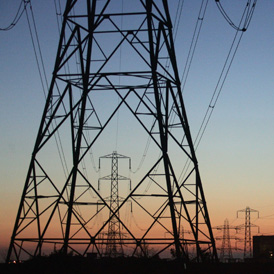Design competition launched for pylon ‘makeover’
The iconic steel electricity pylons that line motorways and spans valleys are due for a major makeover. As Tom Clarke reports, a competition is aiming to make the network more “visually pleasing”.

The Government, the Royal Institute of British Architects and National Grid have launched the competition to design a 21st century pylon to meet the needs of a major new expansion of electricity infrastructure.
Launching the scheme in London, Energy Secretary Chris Huhne said: “This is a chance for today’s architects and designers to influence the landscape for decades to come.”
“We want to revisit the pylon as an icon of the new energy age.”
Hundreds of kilometres of new power lines will be needed to bring electricity from new low-carbon sources.
Geographically isolated wind-farms and nuclear power stations coming on-stream in the next decade will require connection to the existing power network designed around coal and gas burning stations located near to major population centres.
This is a chance for today’s architects and designers to influence the landscape for decades to come. We want to revisit the pylon as an icon of the new energy age. Chris Huhne
The competition comes amid fierce opposition to a number of major new National Grid power line projects in Wales, Somerset and the Scottish Highlands serving new nuclear power stations of offshore wind-farms.
Campaigners are pushing for cables crossing unspoilt areas of countryside to be buried. However, according to National Grid the cost of burying cable can be £10 million pounds per kilometre- 10 times the cost of overhead lines.
“We’re trying to balance the needs of society as a whole to have affordable secure environmentally friendly power with the legitimate wishes of people not to have the views from their houses or villages spoiled,” said National Grid’s Executive Director Nick Winser.
“Hopefully it will be something that people find more modern and more attractive and potentially less visually intrusive. We’ll have to wait and see what all these designers come up with.”
Hopefully it will be something that people find more modern and more attractive and potentially less visually intrusive. Nick Winser, National Grid
Any new electricity pylon will have a tough act to follow. The existing design has changed little since 1927 when leading architect Sir Reginald Blomfield settled on the steel lattice tower for Britain’s nascent power grid.
The steel lattice is cheap and easy to build, it can be repaired without taking it down and can tolerate winds more than 80 miles and hour. The structure also allows you to see the sky and landscape beyond through the structure.
The design competition is focused on the UK’s 22 thousand National Grid pylons – the equivalent to the motorway network for electricity. There are around 66,000 smaller pylons managed by local power companies.
A standard National Grid pylon carries up to 400,000 volts in two circuits of up to 24 separate conductors.
The average is 50 metres high but depending on topography they can be much taller. Britain’s highest are 192 metres carrying cables across the Thames at Darftford.
There is a strict design brief on the National Grid website. New pylons must be as reliable and weather resistant as the existing design, cannot be supported with guy-ropes of cables and must deter members of the public from the potentially fatal mistake of trying to climb one.
The competition closes on 12 July and winners will be announced in the autumn.